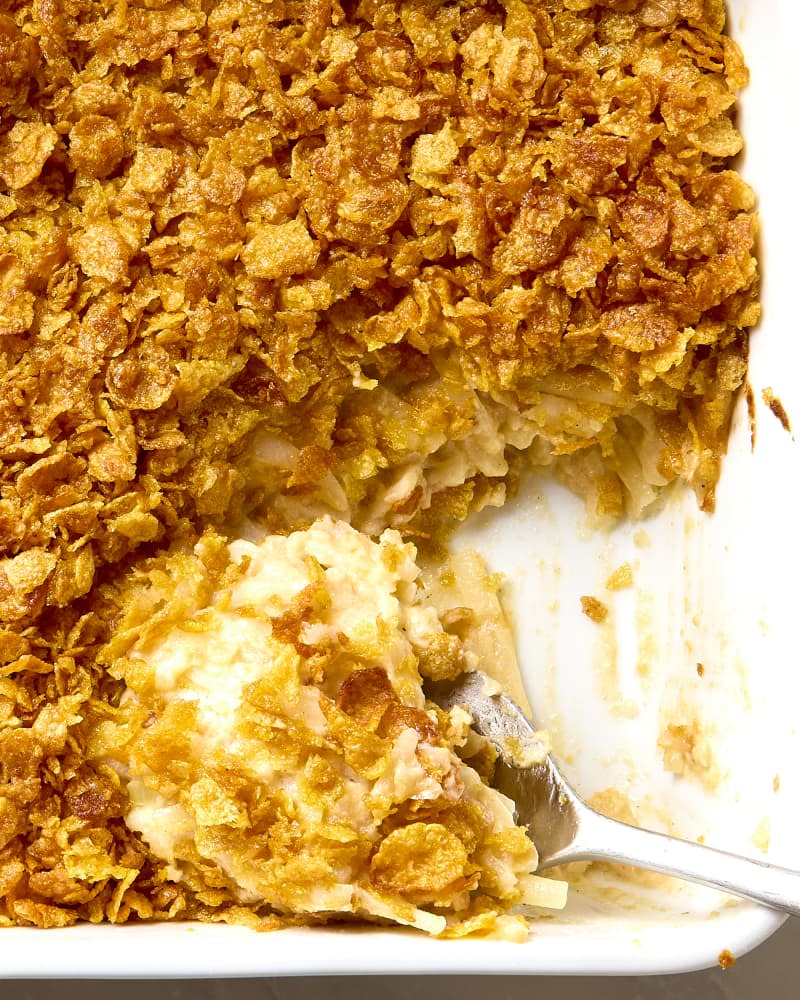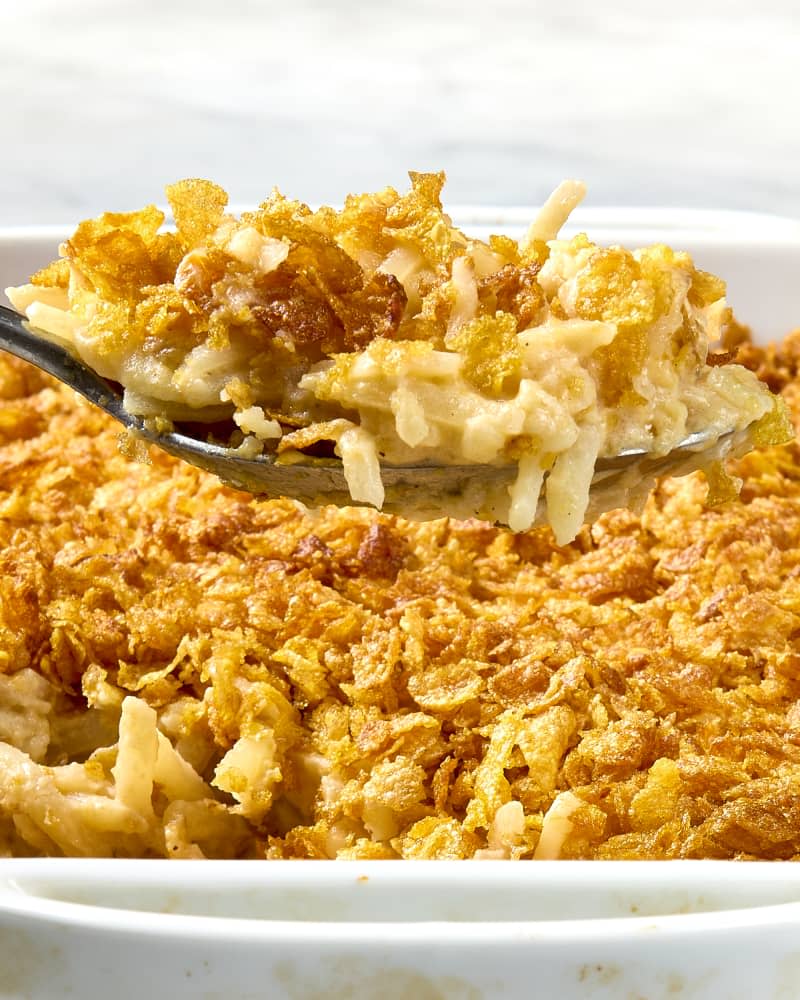My Cheesy Midwestern "Funeral Potatoes" Will Haunt You for Life

Funeral potatoes aren’t just a Latter-Day Saint dish, but they are most often identified with the LDS community and their gatherings — funerals, especially. My friend Whitney Hartshorn, a member of the church, introduced me to funeral potatoes at a potluck years ago. When I reached out to her asking for tips, she shared this explanation, “When someone in our congregation dies, the members of the congregation provide a meal for the family to have after the funeral. Funeral potatoes are easy to scale up and feed a crowd.”
Working on the ultimate funeral potato recipe, I tried out more than a dozen secret ingredients, including horseradish, mustard, dill, hot sauce, and Parmesan, only to realize that I was getting further from my goal with every added dash, drizzle, spoonful, and pinch. Plenty of things pair well with cheesy potatoes, but that doesn’t mean they should all go into this casserole pan.
Making the best possible funeral potatoes doesn’t require any gimmicks. You just have to get the basics right. This from-scratch take on a classic hash brown casserole is simple, adaptable, and worth just a little bit of extra effort.
Why You’ll Love It
It tastes like a potato mac and cheese! The cheesy cheddar sauce is even flavored with some ground mustard (like many classic macaroni and cheese recipes include).
The corn flakes on top are superior. We debated what should blanket the cheesy potatoes and ultimately decided that the light and crispy cereal makes the best crispy topping. It’s classic for a reason.
You can make it easier with frozen shredded hash browns. I like to grate my own potatoes because it yields a slightly firmer texture, but if you’re short on time and want to use a bag of frozen shredded hash browns, the casserole will turn out equally delicious.

Key Ingredients in Funeral Potatoes
Potatoes. Many cooks use frozen hash browns, which make for an easy dump-and-bake casserole. Hartshorn encouraged me to try boiling and grating my own potatoes. “My dad grew up on a potato farm in Idaho, so we rarely do frozen potatoes in my family,” she says. After making a few batches with hash browns, I tried it her way — and I’m not going back. “The difference isn’t huge,” she says, “but I think real potatoes are better.” I do too. Grating parboiled potatoes results in a firmer texture and more earthy potato flavor, and it isn’t a lot more work. That said, if you don’t have time to start from scratch, hash browns are just fine.
Binder. Cream-of soups are a popular addition to this dish. But we’re cooking from scratch, so I’m asking you to make your own easy white sauce, combining broth and milk and infusing it with the flavors of sautéed onion and garlic. It gives the dish a brighter, cleaner flavor, and gives you more control over the ingredients and the outcome.
Cheese: After trying a handful of different cheese options, I ended up back at cheddar, the most popular choice for funeral potatoes. But note that I’m not using just any cheddar. Extra-sharp cheddar adds some twang to this rich casserole, complementing the sour cream and encouraging your guests (this is a dish you make for guests, or family) to go back for second helpings. If you can’t find extra-sharp cheddar, at least go for sharp.
Butter: On the subject of twang, I opted to use cultured butter in this casserole. Cultured butter, which you should be able to find at a local grocery store, is the solid counterpart to traditional buttermilk; it’s soured the same way and provides a lactic bite that also helps brighten up the dish. If you can’t find cultured butter, standard unsalted butter will work.
Cornflakes. The most classic funeral potato topping is also the best. “I’ve only ever used cornflakes as a topping,” Hartshorn says, and after testing cracker crumbs and potato chips, I understand why. Tossing the cornflakes with melted butter helps them toast to a crunchy golden-brown in the oven.
How to Make Funeral Potatoes
Boil and shred the potatoes (or thaw the hash browns). Tender, shredded potato will absorb the cheesy sauce, resulting in a creamy, scoopable casserole.
Make the sauce. Sauté your onion and garlic, stir in and toast the flour, slowly add broth and milk, and simmer to make a rich gravy for your potatoes. Mix in cheese, mustard, cayenne, and black pepper, then add 1 cup of sour cream to brighten it up.
Toss the potatoes in the sauce. Make sure that they are thoroughly coated. Then, pour them into a greased baking dish.
Make the topping. Crush your cornflakes, then toss them in butter (cultured, if you have it) for more flavor. Spread them over the top.
Bake. Bake the casserole until the topping is golden-brown.
Storage and Make-Ahead Tips
If you’re using russet potatoes, they can be boiled and grated up to 3 days in advance, if kept in a bag or sealed container in the refrigerator. The casserole can be made up to 1 day in advance — but don’t add the cornflake topping until just before baking. You can refrigerate leftovers for up to 3 days; the cornflakes will soften, but the dish will still be delicious.
What to Serve with Funeral Potatoes
This is a classic potluck dish that fills the rich, warm, and creamy role more often occupied by mac and cheese. Pair it with other classics, such as stewed green beans, a lighter pasta salad, or a similarly retro broccoli salad, and a buffet-friendly protein, such as glazed ham, beef tenderloin, or even a tray of pulled pork.
Funeral Potatoes Recipe
This retro casserole tastes kinda like potato mac and cheese. (We guarantee they'll haunt you for life!)
Prep time 40 minutes
Cook time 1 hour to 1 hour 15 minutes
Serves 12 to 15
Ingredients
3 medium russet potatoes (2 1/2 to 3 pounds total), or 1 (32-ounce) bag frozen shredded hash browns
2 tablespoons apple cider vinegar
1 tablespoon plus 2 teaspoons kosher salt, divided, plus more as needed
1 medium yellow onion
2 cloves garlic
8 ounces extra-sharp cheddar cheese, preferably orange
8 tablespoons (1 stick) unsalted butter, preferably cultured, divided, plus more for the baking pan
1/4 cup all-purpose flour
2 cups low-sodium chicken broth
1 cup whole milk
1 teaspoon powdered ground mustard
1 teaspoon freshly ground black pepper, plus more as needed
1/2 teaspoon ground cayenne pepper
1 cup sour cream
4 cups cornflake cereal
Instructions
Prepare the potatoes:
If using frozen hash browns: Thaw 1 (32-ounce) package frozen shredded hash brown potatoes in the refrigerator overnight.
If using whole potatoes: Halve 3 unpeeled medium russet potatoes lengthwise. Place in a Dutch oven or medium pot and add enough cold water to cover them about 1 inch. Add 2 tablespoons apple cider vinegar and 1 tablespoon of the kosher salt. Bring to a boil over high heat. Reduce the heat to maintain a simmer and cook until the potatoes are knife tender, about 10 minutes.
Using tongs, transfer the potatoes to a baking sheet. Let cool to room temperature, about 30 minutes. Transfer to a zip top bag or airtight container and refrigerate overnight. (Alternatively, freeze the cooled potatoes on the baking sheet uncovered for 30 to 45 minutes. They won’t grate quite as easily as the refrigerated potatoes.)
Grate the cut side of the potatoes on the large holes of a box grater until you get to the skin (it’s okay if some of the skin gets grated). Discard the skins.
Assemble the casserole:
Arrange a rack in the middle of the oven to 350ºF. Coat a 9x13-inch baking pan with unsalted butter.
Dice 1 medium yellow onion (about 1 1/2 cups) and mince 2 garlic cloves. Grate 8 ounces extra-sharp cheddar cheese on the large holes of a box grater (about 2 cups).
Melt 4 tablespoons of the unsalted butter in a Dutch oven or large saucepan over medium-high heat. Add the onion and sauté until softened and translucent, 5 to 7 minutes. Add the garlic and cook until fragrant, about 1 minute.
Sprinkle 1/4 cup all-purpose flour over the onion and garlic and stir until all of the flour is hydrated. Continue to cook, stirring constantly, until the flour looks and smells lightly toasted, 2 to 3 minutes. While whisking constantly, slowly pour in 2 cups low-sodium chicken broth and 1 cup whole milk. Bring to a gentle simmer. Simmer, stirring frequently and reducing the heat as needed, until the sauce is thickened and coats the back of a spoon, 5 to 7 minutes.
Remove the pot from the heat. Add the cheese, remaining 2 teaspoons kosher salt, 1 teaspoon powdered ground mustard, 1 teaspoon black pepper, and 1/2 teaspoon cayenne pepper. Stir until the cheese is melted. Add 1 cup sour cream and stir to combine. Taste and season with more kosher salt and black pepper as needed. The sauce should be just a little bit saltier than you want the funeral potatoes to be.
Add the potatoes and stir until each piece is evenly coated with sauce. Taste and season with kosher salt and black pepper as needed. Transfer to the baking dish and spread into an even layer.
Place 4 cups cornflakes in a large zip top bag. Crush with your hands into small pieces. Melt the remaining 4 tablespoons unsalted butter in the microwave or on the stovetop. Pour into the bag and shake until the cornflakes are evenly coated. Sprinkle over the potatoes in an even layer.
Bake until the cornflakes are just beginning to brown, 45 to 60 minutes. Let cool for 10 to 15 minutes before serving.
Recipe Notes
Make ahead: The potatoes can be boiled and grated up to 3 days ahead; refrigerate in an airtight container. The casserole can be assembled up to 1 day ahead without the cornflakes; cover and refrigerate. Uncover and top with the cornflakes right before baking, you may need additional baking time.
Storage: Refrigerate leftovers in an airtight container for up to 4 days. The cornflakes will soften, but the casserole will still be delicious.

